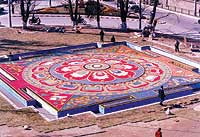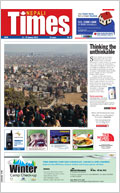 The SAARC summit suddenly stirred the Valley's municipalities from their deep slumber. The main intersections got repaired and widened, traffic islands came up overnight, and suddenly there were parks and wide open spaces. It came at a price: Rs 60 million.
The SAARC summit suddenly stirred the Valley's municipalities from their deep slumber. The main intersections got repaired and widened, traffic islands came up overnight, and suddenly there were parks and wide open spaces. It came at a price: Rs 60 million. But Kathmandu's ambitious mayor Keshav Sthapit assures us all this was not a flash in the pan. "The Nepali mindset needs a big event to get inspired to work. SAARC was one, and the next is the king's coronation," he told us. He seems undeterred by the local government elections scheduled three months from now that will decide whether he remains mayor.
Even Sthapit's diehard critics would agree with that. And despite the cost, they say Kathmandu badly needed a facelift. Maitighar intersection was a case in point: suddenly up popped a garden consisting of the largest mandala in Nepal, surrounded by an astamangala and three traditional spouts. The garden is nearing completion, and the Kathmandu Metropolitan Council is already identifying a private sponsor to maintain it. Jyoti Bhushan Pradhan of the KMC's Public Construction Department says: "We are hopeful. Industries, business houses and offices have volunteered to help maintain 20 traffic island gardens." No less impressive was the way ugly shanties and sand depots gave way to a four hectare park over a matter of days In Tinkune.
 "We had to clear things overnight for SAARC, but the challenge now is to figure out what this city needs in the next decade," says Renchin Yonjan who has been the mastermind behind the KMC's high-profile beautification projects. If Yonjan has her way, Tinkune will turn into a horticultural paradise with a pond, lush trees and walkways. Disagreement over whether it should be the statue of a Buddha or of Manjushree had earlier delayed Tinkune's rehabilitation. Yonjan doesn't think much of either idea. "Look, we have enough Buddhas in our city which are neglected," she told us. "The Buddha himself was against megalomania, he would have preferred a patch of green that is in harmony with nature." After Tinkune, Yonjan wants to work with the Department of Roads on a green belt encircling the city along the Ring Road.
"We had to clear things overnight for SAARC, but the challenge now is to figure out what this city needs in the next decade," says Renchin Yonjan who has been the mastermind behind the KMC's high-profile beautification projects. If Yonjan has her way, Tinkune will turn into a horticultural paradise with a pond, lush trees and walkways. Disagreement over whether it should be the statue of a Buddha or of Manjushree had earlier delayed Tinkune's rehabilitation. Yonjan doesn't think much of either idea. "Look, we have enough Buddhas in our city which are neglected," she told us. "The Buddha himself was against megalomania, he would have preferred a patch of green that is in harmony with nature." After Tinkune, Yonjan wants to work with the Department of Roads on a green belt encircling the city along the Ring Road. The mayor, for his part, is on a building spree. He wants to build 22 km of bicycle tracks, widening 27 km of roads, building 37 new pedestrian overpasses. And he is determined not to let the breakneck pace of SAARC rebuilding to slow. He has enlisted the help of the Department of Roads. Anand Prasad Khanal of the department told us: "We worked hard to meet the SAARC deadline, but it is part of our routine work, which will be continued." But wasn't most of the repair for SAARC shoddy? Khanal admits the repair work was quick fix, but says it will last a year, which is when the next major repair is scheduled.


